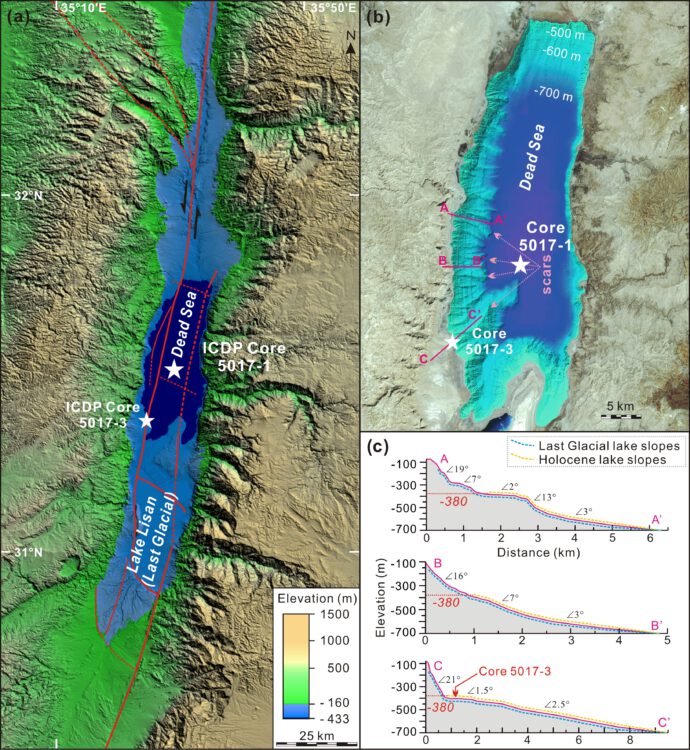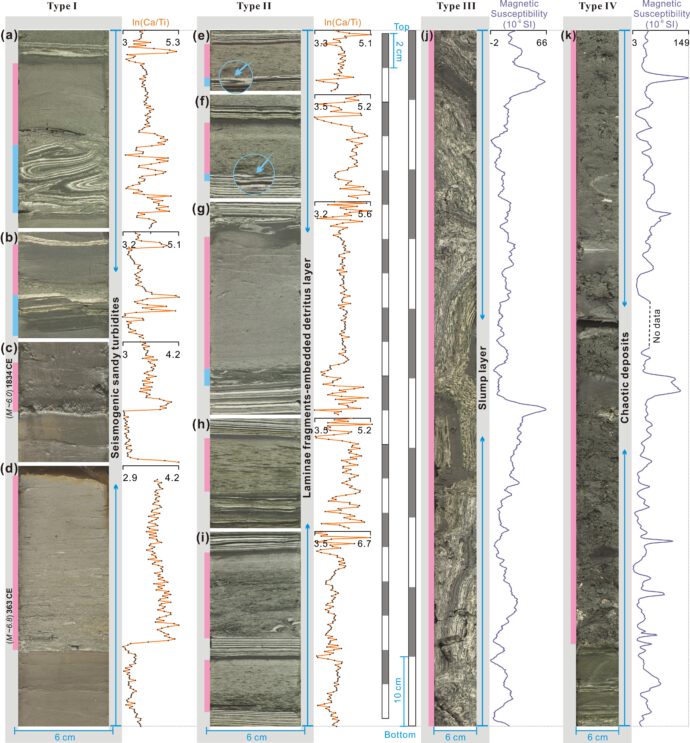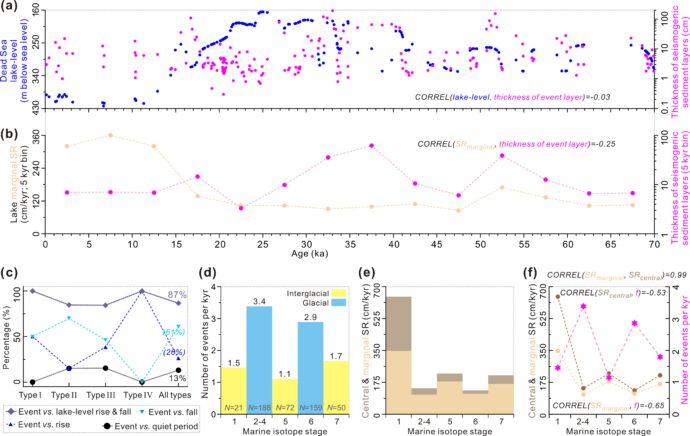A recent study investigated seismogenic mass failure deposits that were preserved in a 457-m deep ICDP drilling (220-0 ka) from the Dead Sea depocenter. The study conducted a critical assessment and testing of the links between the occurrence of seismogenic mass failure, changes in water-level, and sedimentation rate driven by a changing climate.
1. Key Points:
• At the orbital- and millennial-scale, variable sedimentation rates are not a preconditioning factor for earthquake-triggered mass failures
• At the centennial- to decadal-scale, earthquake-triggered mass failures are not statistically correlated with lake-level state
• At the orbital- and millennial-scale, the mass failures are more frequent during lake-level high-stands with large-amplitude fluctuations
2. Overview
Background and significance:
The possible link between the occurrence of submarine mass failure and climate-driven factors is highly disputed. Some researchers demonstrate that lowering sea-level can promote mass failures, while others suggest the opposite. In contrast, some researchers have documented no clear correlation between mass failure occurrence and sea-level change as the ages of failure events appear to be random. They suggested that an accurately-dated record of subaqueous mass failure deposits from a specific setting with the same trigger is key to understanding the possible link.
In addition to the role of water-level, previous studies have suggested that sedimentation-driven overpressure on subaqueous slopes can also decrease slope stability and facilitate mass failures, but rapid sedimentation alone cannot facilitate mass failures.
To address the contrasting viewpoints and interpretations noted above regarding the role of climate in driving mass failure frequency, we present a record from the Dead Sea depocenter that spans the last 220 kyr and comprises 490 earthquake-triggered (seismogenic) mass failure events. This case study provides a unique opportunity to shed new light on the debate by distinguishing and separating trigger and preconditioning factors.
Observations and interpretations:
(1) Seismites in the Dead Sea comprise two categories: one group results from in situ co-seismic sedimentary effects (in situ seismites: folded layers, intraclast breccia layers, and micro-faults) (Marco and Agnon, 1995; Ken-Tor et al., 2001; Wetzler et al., 2010; Lu et al., 2017b, 2020b), and the other group forms by secondary seismogenic sedimentary effects, i.e. seismogenic mass failure deposits (Lu et al., 2017b, 2021).
(2) We subdivide seismogenic mass failure deposits in the Dead Sea into four basic types. (i) Type I: Seismogenic sandy turbidites (Figure 2a-b); (ii) Type II: Laminae fragments-imbedded detritus layers (Figure 2e-i); (iii) Type III: Slump deposits (Figure 2j); (iv) Type IV: Chaotic deposits (Figure 2k).
(3) At the orbital- and millennial-scale, the correlation coefficients between the probability density of events and sedimentation rates are ranging from-0.6 to -0.4, indicate the variable sedimentation rates are not a preconditioning factor for earthquake-triggered mass failures.
(4) At the centennial- to decadal-scale, earthquake-triggered mass failures are not statistically correlated with lake-level state. At the orbital- and millennial-scale, the mass failures are more frequent during lake-level high-stands with large-amplitude fluctuations.
Figures:

Fig. 1. Tectonic setting of the Dead Sea Basin and locations of ICDP drilling.

Fig. 2. Features of seismogenic mass failure deposits (events) in the Dead Sea center (core 5017-1).

Fig. 3. Distribution of seismogenic mass failure deposits (events) in the Dead Sea center over the last 70 kyr, and the correlation between lake-level and sedimentation rate.

Fig. 4. Occurrence of seismogenic mass failure deposits (events) in different lake-level statuses. (a-b) Correlation between the thickness of event layers, lake-level, and sedimentation rate. (c) Percentage of events occurred at different lake-level states over the past 42 kyr (high confidence in lake-level history only). (d) Frequency of events over MIS 7-1 (220-0 ka). (e) Lake marginal and central SR over MIS 7-1. (f) Correlation between sedimentation rate and frequency of events over MIS 7-1.
3. More details can be found at:
(1) (Open Access) https://agupubs.onlinelibrary.wiley.com/doi/10.1029/2021GL093391
Or (2) https://www.researchgate.net/profile/Yin_Lu22
Reference:
Lu, Y., Moernaut, J., Waldmann, N., Bookman, R., Ian Alsop, G., Hubert-Ferrari, A., et al. (2021). Orbital- and millennial-scale changes in lake-levels facilitate earthquake-triggered mass failures in the Dead Sea Basin. Geophysical Research Letters, 48, e2021GL093391. https://doi.org/10.1029/2021GL093391.



URL | 2021-08-10|21:14 (UTC)
… [Trackback]
[…] Read More Infos here: paleoseismicity.org/large-amplitude-changes-in-water-levels-facilitate-earthquake-triggered-mass-failures-in-the-dead-sea-basin/ […]
Laptop | 2022-04-28|04:48 (UTC)
Title
[…] You can see a lot more complete info on this post […]